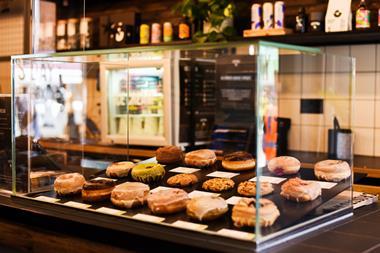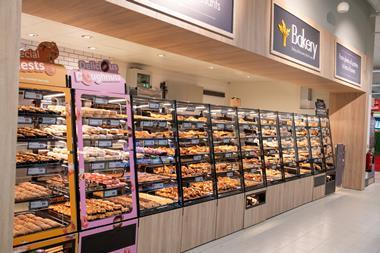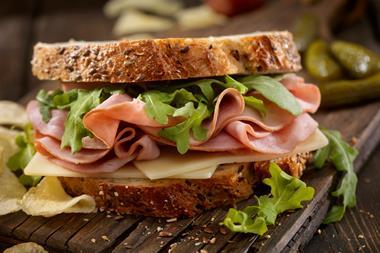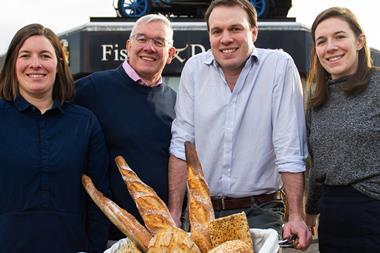Britain is a nation of pie-lovers. Whether enjoying them at football games or as part of a chippy tea, it’s clear the answer to the infamous question ‘who ate all the pies’ is simply ‘Brits’.
In fact, the nation loves them so much it’s currently observing British Pie Week – an annual celebration of the pastry-encrusted treats – taking place from 2 to 8 March.
But tastes have moved beyond a simple meat and gravy pie as consumers demand something a tad more exciting. Here, we explore the trends hitting the pie playground.
Healthy pies are making headway (but they’re not for everyone)
Healthy pies may seem like an oxymoron, but some pie makers are looking to broaden their reach.
“We find our customers want to indulge when they eat our pies – they’re a treat. Having said that, in January we introduced a new limited-edition pie for the month, and it went down a storm with customers,” explains Pieminister managing director and co-founder Jon Simon.
It doesn’t get much healthier than a spinach, kale and edamame beans quick-cooked in lime, soy sauce, garlic and ginger. Called Evergreen (pictured), it’s returning to Pieminister in the summer months.
Higgidy, meanwhile, is embracing the vegan trend and experimenting with different types of seeds, vegetables and grains in its savoury pastries.
Others, meanwhile, are taking a different approach when it comes to health and pies.
“Pies may not be the healthiest meal in the world, but it is an honest meal, made with quality, traceable and organic ingredients. We encourage our meat-eating regulars to try out a veggie pie now and again, as we are just as proud of these as we are our meat pies,” believes Rob Litchfield, head of pie at restaurant Piecaramba, which has sites in Brighton, Southampton and Winchester.
But not everyone agrees with the concept of a ‘healthy pie’.
“My concerns with moving towards ‘healthy pies’ is that you damage a pie’s proposition and make it something it’s not,” says Rupert Willday, head of food at Charlie Bigham’s, which recently rolled out its first range of full-pastry pies, having previously offered pastry-topped ones. “The best approach is to enjoy a pie as an occasional treat and as part of a balanced diet, which should mean that even health-conscious pie fans don’t need to compromise on a classic pie experience.”
Start the day off on a pie
Forget about going to work on an egg, why not try going to work on a pie instead?
“There are ways to diversify a pie, for example you could fill a pastry case with sausage, egg and mushrooms and make it a breakfast pie,” says Charlie Bigham’s Willday.
London-based restaurant Epic Pies is one such establishment to experiment with the idea. Alongside its breakfast menu of eggs benedict and avocado on sourdough toast lies the full English tart – a bountiful breakfast with eggs, two sausages, two bacon rashers, mushrooms and baked beans served in a puff pastry tart base for £7.95 (pictured).
As the brunching hours approach, the opportunity grows.
“Breakfast staples such as bacon, eggs, sausage translate perfectly into pies,” explains Pieminister’s Simon. “In our restaurants we serve a very popular bottomless brunch at weekends, having created three different pies for the occasion (for meat eaters, vegetarians and vegans).”
The offer includes Morning Glory, a sausage and bacon pie with cheesy bechamel and a baked egg, and Sunny Pie Up, a red onion & rosemary veggie sausage pie with bechamel and a baked egg.
Pieminister is also exploring the opportunity for pies in the snacking market with its patties. Although not strictly pies, the four-strong range of patties are made from the brand’s pie lids that are folded in half and filled for an on-the-go snack.
Spice up your life (and your pies)
As the Spice Girls once sang: “Spice up your life.” This advice can also be applied to pies.
“A recent trend seems to be towards eating more spicy foods, incorporating chilli into different recipes to not only add a kick when it comes to flavour but also a touch of vibrancy and colour,” says Alysha Luckin, food director at Higgidy.
Higgidy has tapped into this with its Paneer & Spiced Chickpea and Indian-Spiced Vegetable Pies (pictured).
“We also expect to see more specific chillies named within recipes as consumers become more aware of the different varieties and heat levels available. For example, jalapeno and cayenne are more popular examples and ones that we mention in our own marketing descriptions on pack.”
Part of the reason behind this is growing interest in authentic flavours and global influences on food.
“Aside from Asian and Middle Eastern flavours that are becoming more mainstream, we’re also seeing regional cuisines such Korean and Indonesian increasing in popularity,” Luckin adds.
Mars Foodservice highlights on-trend katsu curry as a pie filling to “satisfy the increasingly adventurous palates of the nation” as well as spicy Mexican flavours.
Pay more attention to pastry
Although a vital component of any pie, the pastry is often an afterthought with much of the attention and creativity given to the filling.
“There’s nothing quite like traditional, all-butter pastry when it comes to making a classic pie. However, there’s no harm in trying out alternatives too. At Higgidy we use seeded spelt shortcrust pastry, using seeds such as linseeds and poppy seeds, to make all our veggie pies and quiches as we find it adds an extra bite and delicious flavour, which complements our fillings,” says Luckin.
“When it comes to pastry, there’s lots of other things you could try, from experimenting with different types of seeds, flours or herbs and spices, to even adding cheese or cocoa powder.”
Pieminister’s patties represent the brand’s first foray into different pastry, with it adding saffron to its vegan shortcrust.
Flavoured pastry is in the pipeline for Piecaramba later this year, but in the meantime multi-coloured pastry does pop up on its menu for special occasions, including a rainbow one for Pride 2019.
Vegan pies are hitting the mainstream
Vegan-friendly food has arguably transcended beyond a trend to become something that is expected. That said, it’s still worth mentioning in the context of pies – a traditionally meat-heavy meal loaded with butter or animal fat in the pastry.
“With veganism expected to jump by an additional 325% this year, it’s no surprise we’re seeing a move towards more vegetarian and vegan pie options – both in restaurants and in home cooking,” says Willday from Charlie Bigham’s.
Rather than detracting from the experience, he believes it will offer more room for experimentation highlighting the use of less traditional vegetable fillings such as pumpkin, beetroot and artichokes.
“The interesting thing about vegetarian and vegan pies is that you have more scope to play and push the flavour boundaries, as you’re working beyond those ingredients found in traditional pies.”
Here are a few recent examples of vegan NPD from pie brands:
- Higgidy launched a Creamy Mushroom & Kale Pie in 2019 which has now been joined by an Aubergine & Spinach Masala Pie as well as Miso Mushroom Vegan Rolls
- Delice de France recently launched two vegan square pies – a Fake & Ale Pie with steak-style strips and baby onions in a vegan ale sauce, and a Saag Mangalore one filled with cauliflower, spinach, chickpeas and lentils in a spicy sauce (pictured).
- Fray Bentos created its first-ever vegetarian pie in 2019, a Vegetable Balti, followed by a Vegan Steak & Kidney Bean one which was named Best Pie at PETA’s annual awards.
Vegan pies are proving they can stand up against meaty counterparts. A curried sweet potato, butternut squash & spinach pie from Jon Thorner’s was named ‘Pie of pies’ at 2019’s British Pie Awards.
Despite their popularity, it’s unlikely they’ll overtake meat pies any time soon. Willday believes the nostalgia surrounding classic meat pies will continue to drive demand.



































No comments yet